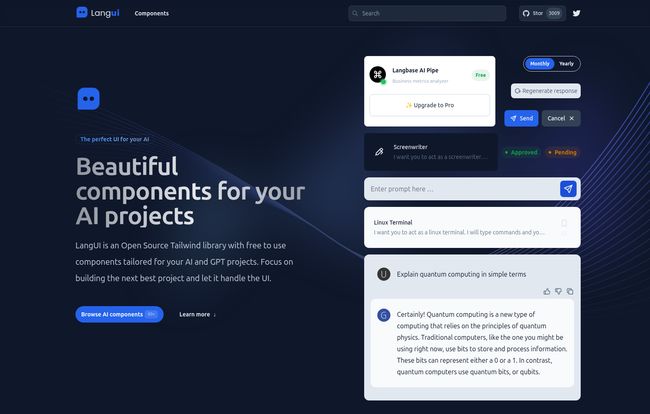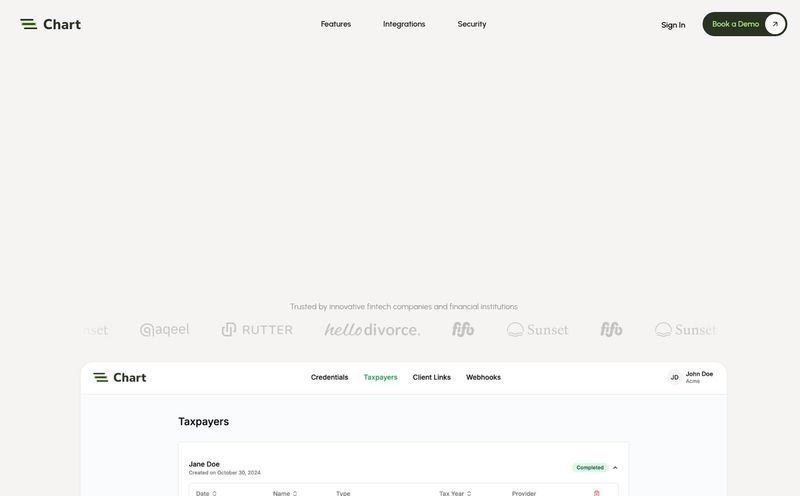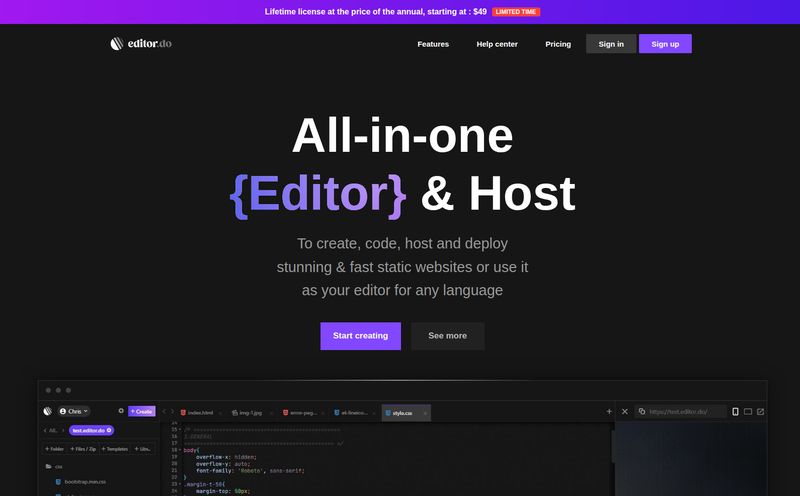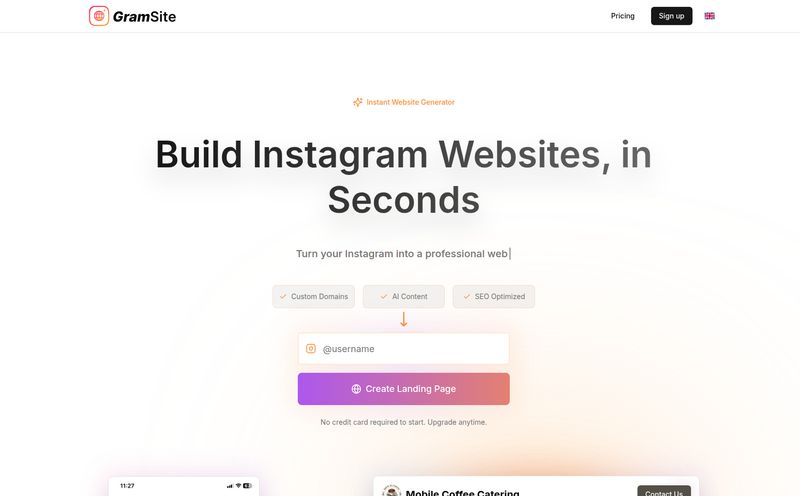We're all caught up in the excitement of prompt engineering, vector databases, and wrangling with the latest GPT model. The last thing most of us want to do is spend a week meticulously crafting a chat bubble or making sure a settings panel looks good in dark mode. It’s the digital equivalent of being asked to hand-carve the furniture for a house you just built.
For years, we've had component libraries for standard web apps—Bootstrap, Material UI, you name it. But the AI space has its own unique UI patterns. We need clean chat interfaces, prompt inputs, and ways to display streaming responses. That's where I stumbled upon LangUI, and I’ve gotta say, I'm pretty intrigued.
It promises beautiful, ready-to-use components specifically for AI and GPT projects, built on Tailwind CSS, and… it’s free. That last part always gets my attention. But is it actually any good? Or is it just another half-baked project that looks good on a landing page? Let's get into it.
What on Earth is LangUI, Anyway?
At its core, LangUI is an open-source library of UI components built with Tailwind CSS. But it’s not a general-purpose library. Its laser-focused on one thing: providing the building blocks for applications that have a conversational or generative AI element. Think of it as a set of specialized LEGO bricks for your next ChatGPT wrapper, AI-powered tool, or data analysis bot.
The whole idea is to let you, the developer, focus on the complex back-end logic—the AI magic—while LangUI handles the front-end drudgery. You get pre-built, beautifully designed elements that you can just drop into your project. And because it's built on Tailwind, it plays nicely with the utility-first workflow many of us already love.
The Things I Genuinely Like About LangUI
I get pitched new dev tools every week, and most of them get a 30-second glance before I close the tab. LangUI held my attention for a lot longer. Here’s why.
It Costs Exactly Nothing. Nada. Zip.
In a world of SaaS subscriptions and tiered pricing plans that require a spreadsheet to understand, the word "free" is a breath of fresh air. LangUI is open source under the MIT License. That means you can use it in your personal side-hustle or your company's next big commercial project without paying a dime. This lowers the barrier to entry to basically zero. It's a massive win for indie hackers, startups, and anyone bootstrapping an MVP on a shoestring budget.
Seriously, Just Copy and Paste
This might be my favorite part. LangUI has zero dependencies and requires zero installation. You don't need to `npm install` another package and bloat your `node_modules` folder (which is probably already heavy enough to achieve its own gravitational pull). You find a component you like on their site, you click 'copy', and you paste the HTML/JSX directly into your code. That’s it. It’s so refreshingly simple. This approach means it's incredibly lightweight and won’t conflict with your existing setup. It's the 'grab-and-go' philosophy, and I'm here for it.
Built for Today's Web (and Tomorrow's AI)
Two things are non-negotiable for modern UIs: responsiveness and a dark mode. LangUI checks both boxes out of the gate. All the components are designed to look great on any screen size, from a massive monitor to a tiny phone. And the built-in dark and light mode support isn't just a toggle; it’s thoughtfully designed. Given that so many of us developers live in dark mode, providing components that match that aesthetic is a smart touch. It shows they understand their target audience.
Let's Be Real: The Not-So-Perfect Parts
Okay, no tool is perfect. As much as I like the concept, there are a couple of things you need to be aware of before you jump in headfirst. I believe in honest reviews, not hype pieces.
You Gotta Know (and Like) Tailwind CSS
This isn't really a flaw in LangUI itself, but a prerequisite. If you're not familiar with Tailwind CSS, you're going to have a bit of a learning curve. The components are built with Tailwind's utility classes (`flex`, `p-4`, `text-white`, `bg-gray-800`, etc.), and to customize them effectively, you need to speak that language. If you're coming from a Bootstrap or traditional CSS background, the long strings of classes can be jarring at first. So, if you're a Tailwind hater, this probably isn't the library for you.
A Growing, Not a Grown, Library
Compared to massive, paid libraries like Tailwind UI, the selection of components in LangUI is… smaller. It's more of a curated collection than an exhaustive one. You’ll find the essentials—chat interfaces, inputs, alerts—but you won't find every conceivable UI element under the sun. I’d describe it as less of a sprawling, all-you-can-eat buffet and more of a curated tasting menu. For a focused AI project, it's probably all you need. But if you're building a massive, feature-rich application, you might find yourself needing to build a lot of custom components to fill the gaps.
So, Who Is LangUI Actually For?
After playing around with it, I have a pretty clear picture of the ideal LangUI user. This tool is perfect for:
- Indie Hackers & Solopreneurs: If you're a one-person army trying to launch an AI app quickly, LangUI is your best friend. It saves you dozens of hours on UI development.
- Startups Building an MVP: Need to get a minimum viable product in front of investors or early users ASAP? This will give you a polished, professional look without the time sink or cost of a custom design.
- Developers Learning AI: If you're focused on learning the AI/ML side of things, you can use LangUI to quickly scaffold a front-end so you have something to interact with.
- Frontend Devs Who Hate Repetitive Work: Even if you're a CSS wizard, do you really want to build another chat bubble from scratch? I thought not.

Visit LangUI
A Quick Peek at the Components
The components themselves are clean and modern. The Chat component, for example, gives you a classic message-and-response layout that's perfect for any chatbot. The Screenwriter is a souped-up text area for prompt inputs, and the Linux Terminal component is a neat, stylized way to show code execution or command-line interactions. They are all just... practical. They solve a real, immediate need that anyone building in this space has.
LangUI Pricing: The Best Kind of Price Tag
I'll dedicate a whole section to this because it's important. How much does LangUI cost? It's free.
There's no pricing page, no pro tier, no hidden fees. It's open-source, and the creator, Ahmad Bilal, seems to be running it as a passion project for the community. The only thing they ask for is a star on their GitHub repository if you find it useful. That’s a trade I’m willing to make any day of the week.
Frequently Asked Questions about LangUI
Is LangUI really free for commercial use?
Yes, absolutely. It's distributed under the MIT License, which is one of the most permissive open-source licenses. You can use it in your commercial projects without any legal headaches. Just don't blame them if your AI takes over the world.
Do I need to be a Tailwind CSS expert to use it?
You don't need to be an expert, but you definitely need to have Tailwind CSS set up in your project and have a basic understanding of how utility classes work. The more comfortable you are with Tailwind, the easier you'll find it to customize the components.
How hard is it to customize the components?
It's as easy as customizing any Tailwind element. Since you're just pasting HTML, you can directly edit the classes to change colors, spacing, fonts—anything you want. They've intentionally used a simple two-color palette to make broad style changes very straightforward.
What if I need a component that isn't in the library?
The creator actually encourages this! There's a 'Request Components' section on the website. You can send in your ideas, and they might just build it. It’s a great way for the library to grow based on actual community needs.
How is this different from other component libraries like DaisyUI or Flowbite?
While libraries like DaisyUI and Flowbite are fantastic general-purpose Tailwind component libraries, LangUI's strength is its specialization. Its components are purpose-built for AI application UIs, which means they solve very specific problems that those other libraries don't necessarily focus on.
My Final Verdict on LangUI
So, is LangUI a game-changer? For the right person, I think it is. It’s not trying to be everything to everyone. It’s a sharp, focused tool designed to solve a very specific, very current problem: making AI apps look good without a lot of fuss.
It democratizes good design for developers in the AI space. It removes a significant roadblock and lets us focus on what we do best—building cool stuff. Sure, it has its limitations, but its strengths—its simplicity, its cost (or lack thereof), and its laser focus—are incredibly compelling.
If you're starting a new AI project and use Tailwind CSS, you should give LangUI a serious look. It might just be the UI shortcut you've been searching for.
Reference and Sources
- LangUI Official Website: https://langui.dev/
- LangUI GitHub Repository: https://github.com/ahmadbilaldev/langui
- Tailwind CSS Official Website: https://tailwindcss.com/
- Ahmad Bilal's GitHub Profile: https://github.com/ahmadbilaldev



